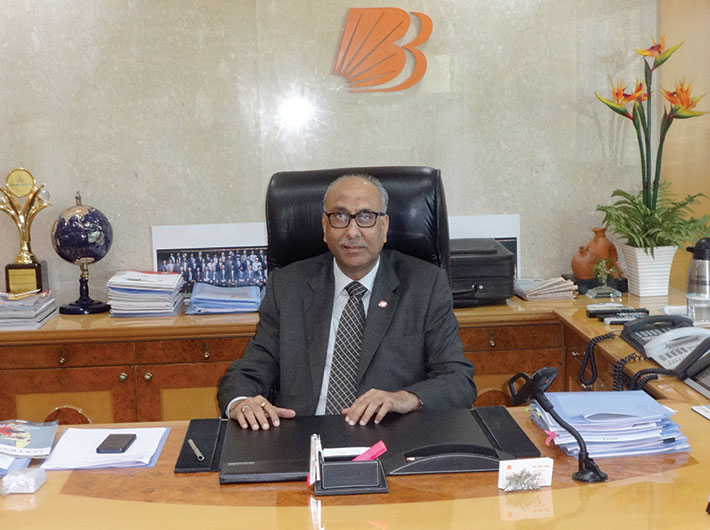Things are moving in a systematic manner and within a decade, banking will no longer be a luxury for anybody, SS Mundra, CMD of Bank of Baroda, tells Governance Now
In a candid conversation with Srishti Pandey at Bank of Baroda's corporate centre in Mumbai, the bank's CMD SS Mundra talks about the changing behaviour pattern of borrowers and lenders, his disagreement with some of the Mor panel recommendations and why NBFCs and MFIs should complement banks for achieving the FI goal. Excerpts:
It has been almost eight years since financial inclusion took off as a pilot project and then became a serious agenda. Yet, the speed with which things have moved is a serious concern. Why?
One often gets to hear comments about how we have not been able to make significant progress in FI despite it being a top priority of the government, RBI, banks, etc. FI started with full force only after the enabling regulation was in place, apprising banks to reach out to under-banked and unbanked areas through business correspondents (BCs). Earlier also banks were opening branches in rural villages but in India, which has around 6.38 lakh villages, by no model of branch opening could all of them be covered. So the BC model was the most significant step taken in that direction. Also, infrastructure and connectivity facilities have improved only in the last few years.
By 2016, our bank has to cover 22,000-odd villages, of which we have already covered around 11,200. We have done this through appointing around 4,700 BCs and have also roped in 2,500 CSCs to work as BCs. All this, along with rural branches and mobile vans, have helped us achieve our target for this year. Once we have outlets in the villages, our focus is on keeping these accounts active and, till February 2014, we have mobilised deposits of Rs 1,684.40 crore in our FI accounts as compared to Rs 238.27 crore in March 2012 and Rs 1,304.74 crore in March 2013.
Also, for micro-credit we have enabled an overdraft facility of Rs 10,000 in all our accounts but only Rs 11 crore overdraft has been availed so far. We are trying to deepen this, after which we will move to micro-insurance and micro-mutual fund.
You are among the few banks using four different delivery models for reaching out to unbanked areas. How has your experience been with each of these models?
We are making use of bricks-and-mortar branches, BCs, mobile vans and now CSCs to ensure last-mile connectivity, and we have learnt a lot from our experiences. In the BC model there is a bank which enters into an agreement with a corporate BC, which in turn employs individuals to work as BCs on the ground. But what happened was that the individual BCs were not very keen about the banking services and so they kept working till they found another opportunity.
Second, the cash flow coming only from banking activities was not enough for BCs to remain motivated to do this job and there was very high attrition because of these reasons. That’s when we decided that though the ground-level BCs are employed by corporates, the bank will actively engage with them. So our branch managers started actively participating in the selection of BCs who could be retired people because in that case sustainability of the model is higher. This took care of the problem of attrition.
However, the problem of revenue still remained and this is where CSCs have come into the picture, because they have multiple streams of revenue. The CSC-as-BC model is much more sustainable and offers greater scope for growth and expansion and hence there is stickiness. We have engaged around 2,500 CSCs already in the last six months since we started using this model. Our BCs – both individuals and CSCs – have also been engaged as business facilitators where they earn additional compensation for procuring loans and ensuring recovery.
How do you decide which model to use in which area?
The CSC model is only six months old. We cannot set up CSCs from scratch and so wherever they are present, they are given the first preference for becoming our BCs. In other areas we either set up branches or employ individual BCs – whichever is a more viable option.
Moneylenders have thrived for so many years because banks were not able to reach out to these areas. But do you see these moneylenders disappearing with the banking penetration increasing now?
I am sure that this will happen for various reasons. One, of course, is that banking reach is happening and people are getting included in the formal banking fold.
In addition, two interesting things will happen simultaneously – on the borrower’s side we can reasonably expect that the next generation will be more literate, aware, and hence would want to be a part of the formal banking channel; and the next generation on the lender’s side will also not be interested in moneylending because of the stigma attached to it. Their aspirations are also growing.
So there will be a change of behaviour pattern on both sides and this, aided with our FI efforts, will ensure that within a decade banking will no longer be a luxury for anybody.
The focus in the initial phase of FI was to reach out to unbanked areas and open accounts. What would you say are the focus points for FI 2.0 and how do you plan to achieve them?
In the second phase, the focus will primarily be on financial deepening and making the FI accounts active. With our Rs 10,000 overdraft facility available for account holders, we need to ensure that more and more people avail this facility, put it to use and then transact in this.
Availing this overdraft facility shouldn’t be a one-off and the demand for credit should go beyond just Rs 10,000. So our endeavour will be to continue opening accounts, enhance transactions, provide credit and also spread literacy about meaningfully using credit which means that banks don’t simply become the hen laying golden eggs. It is important for people to use the eggs instead of slaughtering the hen.
How have you addressed the lack of awareness and coordination of branch staff with BCs for FI? What is the brief that you give to your employees for FI?
We tell them that FI is a serious business proposition and this is not competition-free. There is intense competition here too and if we miss on this business now, then we miss it forever.
And with new banks coming in, this competition is only set to increase.
Well, not just the new banks because they will take some time. There is strong competition even from the existing ones that have started paying serious attention to FI especially in the last two-three years.
Are private banks too giving you a tough fight?
Yes, quite a few of them are. In fact, I do quote examples of some private banks to my employees so that they can be motivated. Because with private banks it is quite clear that they don’t get into any activity which is not money-spinning. So if they are looking at FI seriously, then there
is huge potential for banks to make money in these rural areas.
You were part of the Dr Nachiket Mor panel on FI and you, along with Axis Bank MD & CEO Shikha Sharma, submitted some additional points in the report which did create some stir. Why do you disagree with the 2016 target set by the panel?
While we both agree that it is a good report based on sound principles, there are some things which we don’t agree with – for the simple reason that the purpose of a committee report is to ultimately see the light of the day, meaning it should be implementable.
While providing an account to every adult individual by 2016 is still possible through technology as this can be done at the back-end, it is not enough. There has to be an outlet which can offer at least one deposit product with a rate of return higher than the CPI rate to these account holders. So if we look at all these components together and then put it in the implementation mode, that is where the problem comes and it is not feasible to set 2016 as the deadline. A more realistic target would be to complete this by 2018.
You have also not agreed with the idea of payments banks.
Our view is that enough players are already available in the sector. The idea of payments banks also comes from our impatience for results. It is important to understand that this impatience was justified three-four years ago, but when there is already an enabling mechanism in place and so much progress is visible on the ground, display of impatience could probably be disruptive. In my opinion, pace has gathered momentum and targets have been achieved in the last two-three years. However, if payments banks are to be brought in, there has to be a level-playing field; otherwise there will be imbalances and potential risks for the future.
Why have banks been unable to piggy-ride on the success of mobile penetration for banking?
This subject is often discussed and the most widely quoted example is that of Kenya’s M-Paisa. But this is a mixed experience. There is also some sense of unease about this model. Moreover, in India the level of banking reach is much ahead of those countries. I think this idea needs to be assessed carefully because it comes very close to the payments banks concept.
What about NBFCs and MFIs? Do you see them as complementary or competitive to banks for achieving the FI goal?
While banks have made deep inroads, there would always be certain limitations. We are pan-India institutions and creating customised products or services for every local area will always be limited. Second, we will only be able to offer generic, readymade clauses in contracts instead of tailor-made ones suitable to each person’s needs. And third, in PSBs, there will always be rotation of people and so there are always interruptions in building relationships with the local people.
So in order to be able to operate meaningfully, I believe there is great scope if there can be co-underwriting between banks and these entities (MFIs and NBFCs). There is a great possibility of collaborating instead of competing with each other within the proper regulatory framework and with adequate risk management measures in place.
The advantage with such collaboration is that on the one hand there is capital support and discipline of banks and on the other there is the nimble-footedness of MFIs and NBFCs so that every local area can be provided customised products and services. They should not just be looked at as our BCs but should become partners sharing both risks and returns.
(This interview first appeared in the magazine's March 16-31, 2014 edition)

